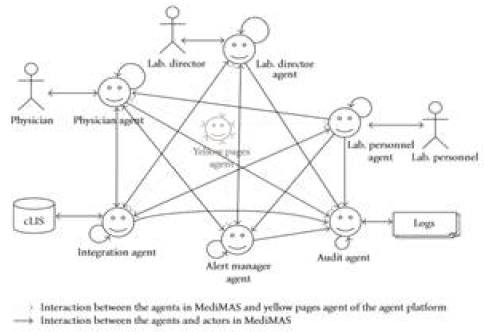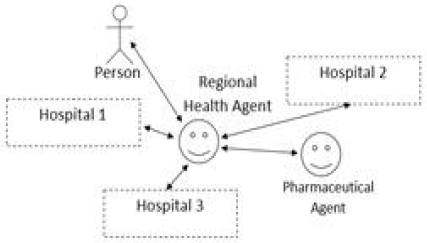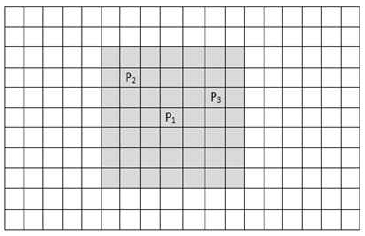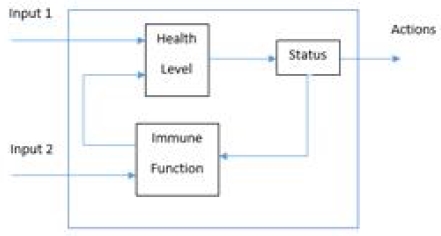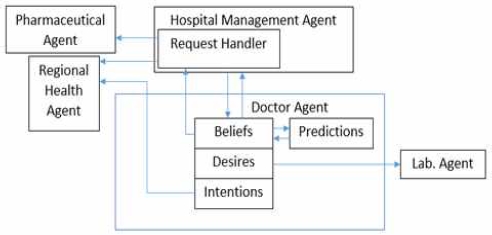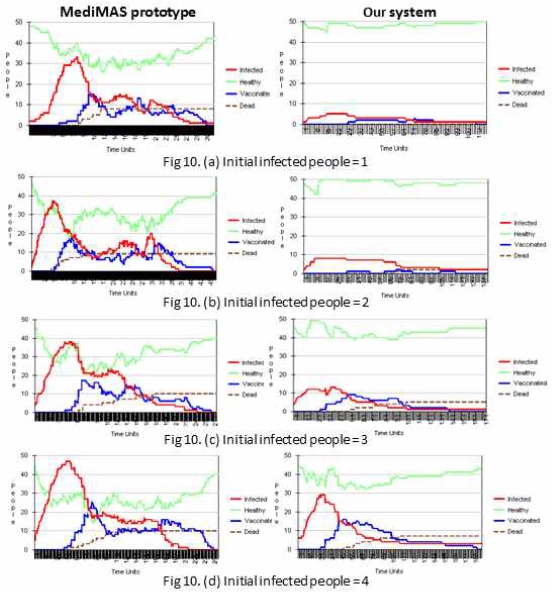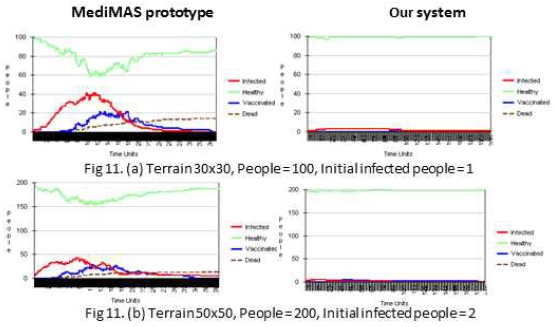
A Infectious Diseases Control Multi-Agent System using Artificial Intelligence Learning Algorithm
Copyright ⓒ 2019 The Digital Contents Society
This is an Open Access article distributed under the terms of the Creative Commons Attribution Non-CommercialLicense(http://creativecommons.org/licenses/by-nc/3.0/) which permits unrestricted non-commercial use, distribution, and reproduction in any medium, provided the original work is properly cited.

Abstract
Emerging infectious diseases have become a threat to humanity and it is still a challenging problem. Epidemiology is one of the important topics in health industry to be addressed to find fast solutions with different researches. Multi-Agent healthcare systems provide considerable solutions but such systems are not properly developed for control infectious diseases. In this dissertation, we propose a multi-agent system for control infectious diseases with extended capabilities for identify and remove infected people from a population. This system prevents an infected person to be in a population by predicting and identifying them so that further spreading of the infectious diseases can be greatly reduced. The goal of this work is to improve the quality of service in healthcare and to protect healthy people from epidemics.
초록
신종 전염병은 인류에게 위협이 되어 왔으며 여전히 해결해야 할 어려운 문제이다. 역학은 보건 관련 분야에서 다양한 연구를 통해 빠른 솔루션을 찾아 문제를 해결해야 하는 중요한 주제 중 하나이다. Multi-Agent 의료 시스템은 다양한 솔루션을 제공하지만 감염성 질병을 통제하기 위해 제대로 개발되지 않았다. 본 논문에서는 감염된 사람을 식별하고 제거할 수 있는 확장된 기능으로 감염성 질병을 통제할 수 있는 다중 에이전트 시스템을 제안한다. 이 시스템은 감염된 사람을 예측하고 식별하여 감염성 질환의 확산을 크게 줄일 수 있도록 함으로써 감염된 사람이 집단에 머무르는 것을 방지한다. 이 논문의 목표는 건강관리 서비스의 품질을 향상시키고 건강한 사람들을 전염병으로부터 보호하는 것이다.
Keywords:
Multi-Agent System, Reactive Architecture, Belief-Desire-Intention (BDI) Architecture, Machine Learning키워드:
멀티 에이전트 시스템, 반응성 아키텍처, BDI (Belief-Desire-Intention) 아키텍처, 머신 러닝1. INTRODUCTION
Sudden arise of infectious diseases can happen on any part of the world so that inability and inefficiency of the existing systems may cause grater instability to maintain a proper protection level and the process of cure sick people will become very slow. This paper aims to explore a better solution by using a multi-agent healthcare system for actively participate in the treatment of patients and monitor the spreading of an infectious disease in a given region.
Infectious diseases are a leading cause of death worldwide, especially in young children, particularly in low income countries. Three infectious diseases were ranked in the top ten causes of death worldwide in 2016 by the World Health Organization. They are lower respiratory infections (3.0 million deaths), diarrheal diseases (1.4 million deaths), and tuberculosis (1.3 million deaths). HIV/AIDS, which was previously on the list, has dropped from the global list of the top ten causes of death (1.0 million deaths in 2016 compared with 1.5 million in 2000), but it is still a leading cause of death in low income countries.
With the advancement of computer technology, various types of new approaches in healthcare systems have arrived in order to provide efficient services for the people to ensure their healthy life. Multi-agent system architecture can be used to develop a better healthcare system for control and overcome the risk of infectious diseases.
Multi-agent healthcare system for control infectious diseases is an idea which takes the full advantages of modern computer systems and their computation power. Implementation of such multi-agent system targets the fact that to construct a strong infrastructure for recover infected people and to prevent further spreading of an infectious disease. Main advantage of this system is to minimize the operational costs and maximize the overall service quality and it is capable of combat with a disease and it can achieve the following goals:
· Keep the rate at which people get cured is higher than rate at which people get infected.· Topology of the multi agent system enhances the agent communication.· Enhance the human resources allocation.· Improve the quality of service for the patients.
2. HEALTHCARE SYSTEM WITH AGENTS.
MediMAS is a healthcare system prototype [1] which uses agents as its basic entities for a multi-agent system. MediMAS introduces different types of agents to facilitate the needs of patients for fast recovery. Figure 1 shows an overview of MediMAS Prototype.
This kind of multi-agent system has variety of agents and complex connectivity among them. A multi-agent healthcare system can be produced by using this prototype but our main requirement is to control immerging infectious diseases so that we need a system with special capabilities which can be utilize for eliminate epidemics. Some agents of the prototype can be identified as important characters for our purpose and we derived a model for a healthcare system in order to fulfill the requirement of control infectious diseases. Figure 2 shows the new system diagram.
However, more improvements for the prototype based system are still possible. Our goal is to predict and identify more infected people in a population so that further infections to healthy people can be reduced. Machine learning capabilities are included with our system with the new agent type called Regional Health Agent and it led the topology change for the derived prototype based system. Figure 3 shows the structure of our proposed healthcare system.
Regional health agent maintains several connections with hospitals. So an infectious disease elimination becomes a collaborative effort for hospitals. A person can connect with the regional health agent to find a hospital. Figure 4 illustrates the typical connectivity of the proposed healthcare system.
Suppose an infected person is reported from location P1. An area which is surrounded by P1 is immediately examined by regional health agent for find more infected people. Figure 5 shows a geographical area with location P1.
Regional health agent performs an action to choose a person on location P2 as infected. If there is a person on location P2 and that person is infected, a positive reward is given to the regional health agent who is to update its Q table maintained by its internal structure. There is a person on location P2 but he is not infected or there are no people on location P2, a negative reward is given. Number of spotted infected people increases with rewards as the accuracy of prediction is getting better. By using this method, many infected people in a population can be guided to hospitals that increase their ability to recover.
Person agent’s body sensor detects and presents health level to owner. It also tells person that whether he should go to a hospital or not. A “healthy” person can be get “infected” by direct contact or by in airborne route. Person agent’s state becomes “infected” and he will lose his health level further and become “sick”. A person is now under treatments. Note that a person still can lose his health level to “very sick” and “severe” until “dead”. A person who has a state which is infected, sick, very sick or severe can be treated and improve health level up to healthy or vaccinated states. A person in dead state cannot change health level or in other words a dead person cannot recover.
Person agent is modeled as a reactive agent. Structure of a Person agent is illustrated in figure 6.
There are two inputs for person agent but neither of them are intended. Input 2 causes infection to person and changes its health level and states. Input 1 gets medication and vaccination. If the status is equal to infected, health level may begin to decrease according to the immune function. Also if a person agent gets medication, health level may increase or decrease. Health level decreases when with poor immune or with week medication. Like Input 1 and Input 2, actions are not intended. If a person is infected, he can infect another person. Doctor agent is responsible for monitor patient status and recommends medications. By examine patient data, a doctor can decide a patient is going to recover or a patient is going to die. Doctor agent is built with Belief-Desire-Intention (BDI) Architecture. Figure 7 shows the doctor agent structure.
By using patient data, doctor agent makes beliefs that a state of a particular patient will become bad with currently available medicine and requests hospital management agent for new drugs. Doctor Agent has a module for prediction which uses analyzing techniques based on past information for make beliefs. Desires for doctor agent is mainly for perform a health level check in order to know the accurate state of a patient. Doctor agent has intentions for contact Regional Health Agent in order to update current status of disease strength.
4. RESULTS
An infectious disease can spread in the entire region and each person becomes a susceptible for get infected. There are also infected people and finally they become recovered. This is the main feature of a compartment model [5]. Simplest of them is the Susceptible-Infected-Recovered (SIR) Model which is used for simulate epidemics in many agents based systems [2][3]. In the following paragraphs, we simulate several scenarios and measure its capabilities with MediMAS[1] prototype based system. We used a simulated environment with number of people for build a scenario of a typical city. Many multi-agent systems for understand the infectious diseases use Susceptible-Infected-Recovered (SIR) Model with the assumption that, for a period of time in a population, there are no newborns and deaths. In other words, such models do not consider population’s vital dynamics [4]. Our system uses a model which is not purely SIR but in order to examine its functionality, it executed a simulation session without vital dynamics. For that case we used a terrain with 200 people to see its outputs. Figure 8 shows two graphs for expected results of SIR Model. Figure 8 (a) is the expected output for SIR Model [5]. Figure 8 (b) shows results from our proposed system produced. At the beginning (t0=0), when an epidemic starts, all people are susceptible.
Then infected people count grows rapidly because susceptible people are now becoming infected ones. Finally, the population develops a resistance over the epidemic and change to be recovered so only recovered people remains. Validation of an agent based simulation by using a mathematical model [3] is very essential in such a way that we can align existing systems properly. Our simulated population shows the behavior that SIR Model expected and our multi-agent system’s output gave an acceptable graph which is similar to SIR model.
However, our system has a derived model that is not exactly similar to SIR model. In our system, a person who is recovered can be getting infected again. A person can also be dead. That sense it is clear to follow vital dynamics. Figure 9 shows obtained results in the form of a graph. We denoted susceptible as healthy people.
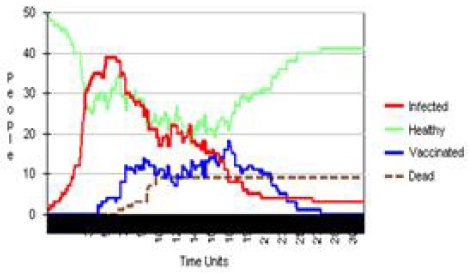
Obtained results.(Variations of the totals of Infected, Healthy, Vaccinated and Dead people during the healing process.)
At the beginning (t0) there were 50 healthy people in the population and the number of infected people grows with time. System identifies and tries to recover people from the epidemic. A person who is able to recover from the disease is vaccinated before he discharges from the hospital. Vaccinated is also a state of a person but it is temporal so that after some time his state is changed into healthy which means he is susceptible again. People who cannot recover change their state to dead.
Our proposed multi-agent system is tested and we compared its results with MediMAS prototype based system in order to identify the improvements. When the simulation starts (t0), we put some infected people into the population. Those infected ones infect healthy people and the number of infected count grows. Infected people go through a healing process for change their states to healthy and finally vaccinated people arrive to the population. Their vaccination remains for some time and after that they change to healthy (susceptible) ones. At that time when the population only has healthy (susceptible) people and no infected ones, we finished monitoring at put those data on a graph. (But there may be few infected people still in the hospitals who do not affect the population).
A terrain size 1x1 is an area of 200x200 pixels on our simulation ground. Each one of the above categories further has 4 sub categories where initial infected people count is 1, 2, 3 or 4. For all of these categories and for all comparisons, an independent experiment has been done. First category, a population with 50 people on a 20x20 terrain is conducted with 1 to 4 initial infected people until the population only has healthy people. Results are shown in Figure 10.
At the end of the simulation, only the healthy people remain on the terrain. Our system can prevent the spreading of the epidemic and can recover many people than the MediMAS prototype based system. It can control the spreading so those at any time there are only few infected people remain in the terrain than the MediMAS prototype. Figure 11 shows more results for different terrain sizes.
According to the results our system has a better control over an epidemic spreading and it can greatly reduce the possibility of healthy people become infected. Healthcare agents and agent communication network of our multi-agent system provide efficient background for make faster the healing process. This can also reduce the completion time.
A person who is recovered is vaccinated and is returned to population. After some time vaccinated person becomes a normal (healthy or susceptible) person again. At the time when all people achieve this state is called the completion time. After that further epidemic spreading is not possible because there are no infected people remains in the population.
According to the results our system has a better control over an epidemic spreading and it can greatly reduce the possibility of healthy people become infected. Healthcare agents and agent communication network of our multi-agent system provide efficient background for make faster the healing process. This can also reduce the completion time. In addition, our system can give service to mostly all of the patients with the high rate of satisfaction.
5. CONCLUSION
In this dissertation, a multi-agent healthcare system is proposed for control of infectious diseases, which uses a better agent arrangements and communications for provide faster responses to eliminate an epidemic outbreak in a short period of time. This arrangement of agents can extend the average agent capabilities and can minimize the operational costs and maximize the service quality.
In addition, we introduced a method for predict more infected people by searching the surrounded area of a newly reported infected person. This method helps to spot many infected people from a single search and remove them from the population quickly so that it prevents further spreading of the diseases.
Our system is evaluated for its performance by comparing it with MediMAS prototype based system. We calculated the completion time that is the population has only healthy (recovered) people. Total reported infections have counted for understand the protection which is given by system for the population. Also the percentage of the saved people in the population is stated.
According to the results, our proposed multi-agent system can perform well and it can bring people in a population into healthy state in a very short time. It can prevent further spreading of an infectious disease. Also it can recover more people than other systems.
Our goal is to expand the coverage and make this system have a greater performance over all prototype based systems.
References
-
Minh Tuan Nguyen, Patrik Fuhrer and Jacques Pasquier-Rocha, “Enhancing E-Health Information Systems with Agent Technology,” International Journal of Telemedicine and Applications, Volume 2009. Article ID 279091, 13 pages.
[https://doi.org/10.1155/2009/279091]

- Russell Connell, Peter Dawson and Alex Skvortsov, “Comparison of an Agent-based Model of Disease Propagation with the Generalised SIR Epidemic Model,” DSTO Defence Science and Technology Organisation, 2009.
- Skvortsov, A.T.R.B.Connell, P.D. Dawson and R.M. Gailis, “Epidemic Modelling: Validation of Agent-based Simulation by Using Simple Mathematical Models,” International Congress on Modelling and Simulation, Modelling and Simulation Society of Australia and New Zealand, Princeton University Press, pp. 657-662.
- Hong Qin, Alexander Shapiro, and Li Yang, “Emerging Infectious Disease: A Computational Multi-agent Model,” 2012 ASE / IEEE International Conference on BioMedical Computing,, Nov. 2012.
- Wikipedia. Compartmental models in epidemiology. https://en.wikipedia.org/wiki/Compart

1993년 : 동국대학교 대학원 응용생물학과 (이학박사)
2019년 : 전북대학교 공과대학 컴퓨터공학과 박사수료
1996년~현재: 고구려대학교 피부미용과 교수
2012년~현재: 대한미용문화예술학회장
※관심분야: 인공지능, 헬스케어, 생리활성 뷰티미용 등

1996년 : 원광대학교 교육대학원 컴퓨터공학과(교육학석사)
2003년 : 원광대학교 대학원 컴퓨터공학과(공학박사)
2001년~현재: 한국폴리텍대학 인천캠퍼스 컴퓨터정보과 교수
※관심분야: 유비쿼터스 컴퓨팅, 헬스케어, 인공지능 등

1996년 : 전북산업대학교 산업기술대학원 건축공학과 졸업(공학석사)
2005년 : 전북대학교 건축공학과 졸업(공학박사)
2006년~현재: 호원대학교 건축공학과 교수
※관심분야: 유비쿼터스 컴퓨팅, 건축구조, 융합과학 등
